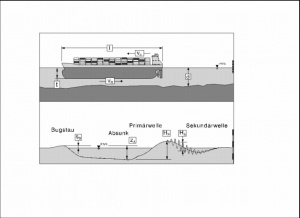Ship-generated Loading: Difference between revisions
From BAWiki
No edit summary |
|||
| Line 8: | Line 8: | ||
==Definition of the Characteristic Parameters== | ==Definition of the Characteristic Parameters== | ||
[[de:Definition der Kenngrößen]] | |||
[[File: Seb.Bild2.jpg|thumb|Graph 1: Parameters and Functional Dependencies]] | |||
A moving ship generates waves of different periods as a consequence of its displacement current causing pressure and water level changes at its bow, stern and alongside its hull. The following parameters describe the ship wave and current system, for example, for a ship moving in an estuary at subcritical speed (ship speed less than the phase speed of the prevailing waves): | |||
* the bow pressure ('''s<sub>B</sub>''') directly at the hull, | |||
* the water level depression ('''z<sub>A</sub>''') at the side of the ship, | |||
* the stern wave ('''H<sub>P</sub>''') which is a part of the long period primary wave system, | |||
* the secondary wave superimposed on the primary wave system ('''H<sub>S</sub>'''), | |||
* velocity ('''v<sub>R</sub>''') of the simultaneously occurring return current. | |||
The water level changes for a depth- and width-limited waterway, as seen by an observer from the bank, are shown as a vertically exaggerated sideview in the above sketch. | |||
<br /> | |||
==Functional Relationships== | ==Functional Relationships== | ||
==Analytical and Empirical Methods== | ==Analytical and Empirical Methods== | ||
Revision as of 10:29, 7 April 2022
The change in draught- and speed-related ship-induced loading on the shipping routes entails a definition of the characteristic parameters (e.g. ship wave system, displacement current) and requires knowledge of the functional relationships (e.g. ship speed and vessel width, shipping channel conditions, passing clearance). Picture 1 shows a diagram of the ship wave system among others.
Since the start of the new century, a large number of analytical and empirical methods have been developed for calculating the interaction of ship and waterway. Initial calculations with hydrodynamic-numerical models reveal deviations compared to the results of hydraulic scale models, so that these numerical models cannot yet be viewed as a confirmed scientific aid for determining upgrading-related changes to ship-induced loading in shipping channels. At the moment, it is only possible to make confirmed quantitative predictions of ship-induced loadings in inhomogeneous waterways by means of hydraulic model tests in a scientifically confirmed model scale (state-of-the-art engineering and science).
In recent years, the BAW Hamburg office has looked at the issue of the interaction between seagoing ship and tidal fairways both with studies on hydraulic models and with field study measurements.
Definition of the Characteristic Parameters

A moving ship generates waves of different periods as a consequence of its displacement current causing pressure and water level changes at its bow, stern and alongside its hull. The following parameters describe the ship wave and current system, for example, for a ship moving in an estuary at subcritical speed (ship speed less than the phase speed of the prevailing waves):
- the bow pressure (sB) directly at the hull,
- the water level depression (zA) at the side of the ship,
- the stern wave (HP) which is a part of the long period primary wave system,
- the secondary wave superimposed on the primary wave system (HS),
- velocity (vR) of the simultaneously occurring return current.
The water level changes for a depth- and width-limited waterway, as seen by an observer from the bank, are shown as a vertically exaggerated sideview in the above sketch.
Functional Relationships
Analytical and Empirical Methods
Hydrodynamic Numerical Methods
Author: K. Uliczka
- Definition of the Characteristic Parameters
- Functional Relationships
- Analytical and Empirical Methods
- Hydrodynamic Numerical Methods
back to Hydraulic Modelling
